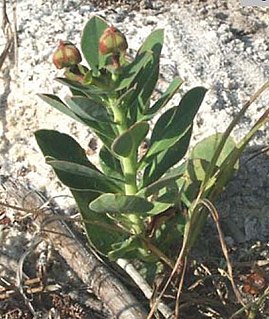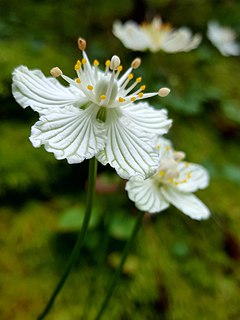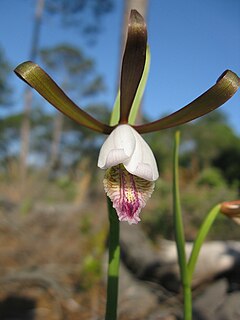
The longleaf pine is a pine species native to the Southeastern United States, found along the coastal plain from East Texas to southern Maryland, extending into northern and central Florida. It reaches a height of 30–35 m (98–115 ft) and a diameter of 0.7 m (28 in). In the past, before extensive logging, they reportedly grew to 47 m (154 ft) with a diameter of 1.2 m (47 in). The tree is a cultural symbol of the Southern United States, being the official state tree of Alabama. Contrary to popular belief, this particular species of pine is not officially the state tree of North Carolina.

Flatwoods, pineywoods, pine savannas and longleaf pine-wiregrass ecosystem are terms that refer to an ecological community in the Southeastern coastal plain of North America. Flatwoods are an ecosystem maintained by wildfire or prescribed fire and are dominated by longleaf pine, and slash pine in the tree canopy and saw palmetto, gallberry and other flammable evergreen shrubs in the understory, along with a high diversity of herb species. It was once one of the dominant ecosystem types of southeastern North America. Although grasses and pines are characteristic of this system, the precise composition changes from west to east, that is, from Texas to Florida. In Louisiana, savannas even differ between the east and west side of the Mississippi River. The key factor maintaining this habitat type is recurring fire. Without fire, the habitat is eventually invaded by other species of woody plants.

The Arboretum of the University of Central Florida is located on the main campus of the University of Central Florida in Orlando, Florida, United States. Covering 80 acres (320,000 m2), it contains more than 600 species of plants, including more than 100 bromeliads, in cultivated gardens.

Calopogon, grass pink, is a genus of terrestrial orchids. The generic name is from Greek and means "beautiful beard", referring to the cluster of hairs adorning the labellum. The five species are native to the eastern United States, eastern Canada, Cuba and the Bahamas. The genus Calopogon is abbreviated Cpg in trade journals.

De Soto National Forest, named for 16th-century Spanish explorer Hernando de Soto, is 518,587 acres of pine forests in southern Mississippi. It is one of the most important protected areas for the biological diversity of the Gulf Coast ecoregion of North America.

The frosted flatwoods salamander is a small, elongated species of mole salamander. It has a small, indistinct head, short legs, and a long, rounded tail. Typical coloration consists of a background of brownish- to purplish-black overlaid with narrow gray or silvery-white reticulations, bands, or diffuse spotting. The gilled aquatic larvae are distinctly colored, having a series of bold brown and yellow longitudinal stripes.

Sarracenia leucophylla, also known as the crimson pitcherplant, purple trumpet-leaf or white pitcherplant, is a carnivorous plant in the genus Sarracenia.

A wet meadow is a type of wetland with soils that are saturated for part or all of the growing season. Debate exists whether a wet meadow is a type of marsh or a completely separate type of wetland. Wet prairies and wet savannas are hydrologically similar. Wet meadows may occur because of restricted drainage or the receipt of large amounts of water from rain or melted snow. They may also occur in riparian zones and around the shores of large lakes.

Platanthera ciliaris, commonly known as the yellow fringed orchid, yellow-fringed orchid, or orange-fringed orchid, is a large and showy species of orchid. It grows in "acid soil of hillside seepage bogs" in the longleaf pine landscapes of the Gulf Coast. Like many species in these habitats, including flatwoods, it is dependent upon recurring fire to create open conditions. Further north it is found in bogs, but even here it may be dependent upon fire to create open conditions.

The gopher frog is a species of frog in the family Ranidae, endemic to the south-eastern United States. It primarily inhabits the threatened sandhill communities, flatwoods, and scrub in the Atlantic coastal plain, where it is usually found near ponds.

The eastern savannas of the United States covered large portions of the southeast side of the continent until the early 20th century. These were in a fire ecology of open grassland and forests with low ground cover of herbs and grasses.

Euphorbia telephioides is a rare species of euphorb known by the common name Telephus spurge. It is endemic to Florida in the United States, where it is known only from three counties in the Panhandle. It is a federally listed threatened species of the United States.

Lysimachia asperulifolia is a rare species of flowering plant in the Primulaceae known by the common name rough-leaved loosestrife and roughleaf yellow loosestrife. It is endemic to the Atlantic coastal plain in North Carolina and northern South Carolina in the United States, where there are 64 known populations. It is a federally listed endangered species of the United States.

Pinguicula ionantha is a rare species of flowering plant in the butterwort family known by the common names Godfrey's butterwort and violet butterwort. It is endemic to the US state of Florida, where it only occurs in the central Florida Panhandle. It is threatened by the loss of its habitat, and it is a federally listed threatened species of the United States.

Arundinaria gigantea is a species of bamboo known as giant cane and river cane. It is endemic to the south-central and southeastern United States as far west as Oklahoma and Texas and as far north as New York. This species is divided into two subspecies. The subspecies tecta is sometimes treated as a species in its own right, Arundinaria tecta, and is the taxon generally called switch cane. It is very similar to the nominate subspecies (gigantea), but is often smaller and tends to grow in wetter habitats.

Parnassia caroliniana is a species of flowering plant in the Celastraceae known by the common name Carolina grass of Parnassus. It is native to the southeastern United States, where it occurs in North Carolina and South Carolina, with an isolated population in the Florida Panhandle.

Platanthera flava, the palegreen orchid, is a species of pale-flowered orchid. It is native to eastern North America, from Texas east to Florida, north to Ontario, Quebec and Nova Scotia.

The longleaf pine ecosystem is a climax temperate coniferous forest habitat found within the southeastern United States; it includes many rare plant and animal species, and is one of the most biodiverse in North America. Once the largest ecosystem in North America, it now occupies less than a quarter of the original range. Degradation of the ecosystem is partially due to excessive timber harvesting, urbanization, and fire exclusion. Although the ecosystem is heavily fragmented at present, it still carries a great diversity of plant and animal species, many of which are endemic. A range of techniques, including planting longleaf seedlings, introducing prescribed burning regimens, managing native ground cover, and controlling invasive species within the ecosystem, are used in attempting to preserve this threatened ecosystem.

Cleistesiopsis is an orchid genus in the tribe Pogonieae. Its members were included in Cleistes until 2009. Cleistesiopsis is native to the eastern and southeastern United States from New Jersey south to Florida, and west to Kentucky and Louisiana. The common names are rosebud orchid and small spreading pogonia.
Ruellia noctiflora, the nightflowering wild petunia, is a herbaceous perennial found along the Gulf coast. Both its specific and common names derive from its habit of nocturnal flowering. In spite of the common name it is in a different family from the garden petunia.





















